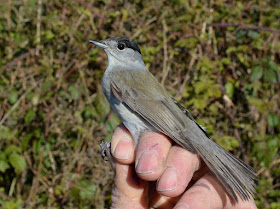I have been up to the ringing site at Billinge twelve times since 6th April but the catches have been quite small, hence the lack of blog posts about individual visits. While the catches have been small they haven't been without interest and what you don't catch can be as important as what you do, or at least that is what I tell myself.
It looks like being another poor spring for Redpoll passage but that is hardly surprising as last autumn was very poor for Redpolls going south so a poor showing the following spring is no big surprise. Having said that you have to put the effort in to find out and I can certainly say I have put the effort in with only 18 Lesser Redpolls caught over twelve visits. One of the Redpolls caught on 10/04/2019 was a retrap that had been ringed at the site on 13/08/2017 as an adult female so perhaps a bird that breeds not too far away.
The most interesting Redpoll, for me at least, was a little adult male caught yesterday (21/04/2019). I say little as its wing length was 69mm which is fairly small or very small for a male of any race. We still don't know what to do with Redpoll species and races because they don't play by the rules as we would like to apply them. If my understanding is correct they should all be lumped at a genetic level, every last one of them, into one species because they are not distinct enough genetically despite their varying appearance. Arctic, Common, Lesser or whatever you want to call them they are all far more similar on the inside than they appear on the outside but that is what makes them even more fascinating. While they may be similar on the inside the difference on the outside largely determines where they will breed and that is why we like them so much.
 |
| A bit or quite a bit greyer than your typical Lesser and probably breeds well north of Billinge. |
 |
Broad white fringes to the greater coverts, tertials and inner webs of tail feathers.
A touch of tram lines up the mantle too. |
 |
| Broad white fringes to the greater coverts and tertials. |
 |
| Broad white fringes to inner webs of tail feathers. |
 |
| Unstreaked under-tail coverts which is normally a feature of Arctic Redpolls. |
 |
| Pure white, unstreaked, under-tail coverts, including the feather shafts. If you hadn't seen the rest of the bird you could be thinking Arctic Redpoll. I have seen Lesser types like this before so not as exceptional as it may appear. |
The first Willow Warbler was noted on the 6th and it was good to find that 9 of the 20 that were caught between the 10th and 22nd were retraps. Of the retraps one was originally ringed in 2016 and eight were originally ringed in 2017. On the other hand Chiffchaffs have been thin on the ground this spring with only 3 caught but all were retraps - one from 2017 and two from 2018. Blackcaps have put in a pretty good showing so far with 12 caught - 10 new, 1 retrap and 1 control. The retrap was ringed as a first-year in August 2017 and the control was ringed 16 km away at Woolston Eyes in April 2018.
Unusual captures were a pair of Mistle Thrushes that found their way into one of the nets on the 16th and were a first to be ringed at the site. However, the highlight of the period, and what made the effort worthwhile, was the capture of six Tree Pipits with the first caught on the 13th.
 |
| Tree Pipit 19/04/2019 |
 |
| Tree Pipit 21/04/2019 |
The twelve visits yielded 54 new birds, 18 retraps and 1 control as follows (retraps in brackets): Lesser Redpoll 17 (1); Willow Warbler 11 (9); Chiffchaff (3); Goldcrest 2 (1); Blackicap 10 (1) +1 control; Robin 3; Long-tailed Tit (1); Tree Pipit 6; Mistle Thrush 2; Bullfinch 1 (1); Dunnock 1; Yellowhammer 1; Willow Tit (1).























